UPDATE: you can now upload YOUR pictures of starfish wasting disease. They are being tracked at this website (iNaturalist)
Last week I reported on an unusually large die-off of the North Pacific sunflower star, Pycnopodia helianthoides (among other starfish species) in the waters of British Columbia. The story even got picked up by National Geographic!
This sparked some good academic discussion here which I can only hope will lead to some further insight into what is happening. One useful thing which came up was the mention of something that would be a good follow up to last weeks' report: Starfish Wasting Disease!
I have spoken of ciliate protist parasites in sea stars before but this is something different.
Details of the post today about Starfish wasting disease is based on this paper in the journal, Diseases of Aquatic Organisms from an article by Amanda Bates, Brett Hilton and Christopher Harley in 2009
Other information is from an account of starfish wasting disease in the Channel Islands by Ginny Eckert and colleagues. This paper is freely available here.
I should also mention that my friend and colleague Dr. Allison Gong has documented an outbreak of wasting disease in her water table at UC Santa Cruz. I've borrowed many of her pictures below. My thanks to her for allowing me to use them!
What is Starfish Wasting Disease?
Symptoms of the disease are relatively straightforward:
- White colored lesions appear and grow rapidly
- There is a loss of body pressure (i.e., turgor)
- Body disintegration and autotomy of arms, etc.
- and finally death...
 |
| Fig. 2 from Bates' et al. 2009 |
Lesions...
followed by decay and autotomy (i.e., arms begin to shed..)
The effects DO seem very similar to what happened with the Pycnopodia die-off
But what actually causes the disease?? Sadly, we are just beginning to understand it and so we don't actually know WHAT the causative agent is. Molecular tests for bacteria haven't confirmed anything.
Could it be a virus? A fungus? Some strange combination thereof?
Its also unclear if it is the SAME agent at work in EVERY case. Different species? Different strains? Different diseases?
The symptoms of the disease have been documented widely: on the west coast of North America. From British Columbia down to the Gulf of California. But also in the Mediterranean and the North Atlantic coast of North America.
Nothing yet from the Southern Hemisphere.. Australia, New Zealand, etc.
What Species Does It Affect?
Wasting disease appears to be pretty widespread across MANY starfish groups.
The symptoms of the disease have been observed as early as 1972 from the east coast of North America in the "common" starfish Asterias vulgaris (now called Asterias rubens, pic on the left)
In 1982, there was a mass die-off of Heliaster kubiniji in the Gulf of California, which was so severe that it led to local extinction in several areas where it had once been abundant. (Image of Asterias by "misenus1", Image of Heliaster by manzanita-pct)
Temperature! The Key to Wasting Disease
Eckert's paper speculated that warmer waters in the Southern California region accompanied the onset of wasting disease in the species they studied.
Amanda Bates & her team study studied Pisaster ochraceus in British Columbia and studied several variables and how they affected the disease.
Indeed, temperature turns out to be a very important factor in the spread of starfish wasting disease!
The graph below shows that the prevalence of the disease in starfish under experimental conditions is significantly higher under warmer conditions. This was also reflected by observations in the wild as they saw higher incidence of disease in the summer (June) than in August.
The effects DO seem very similar to what happened with the Pycnopodia die-off
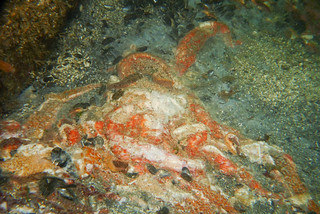 |
| fr. Jonathan Martin |
Could it be a virus? A fungus? Some strange combination thereof?
Its also unclear if it is the SAME agent at work in EVERY case. Different species? Different strains? Different diseases?
The symptoms of the disease have been documented widely: on the west coast of North America. From British Columbia down to the Gulf of California. But also in the Mediterranean and the North Atlantic coast of North America.
Nothing yet from the Southern Hemisphere.. Australia, New Zealand, etc.
What Species Does It Affect?
Wasting disease appears to be pretty widespread across MANY starfish groups.
The symptoms of the disease have been observed as early as 1972 from the east coast of North America in the "common" starfish Asterias vulgaris (now called Asterias rubens, pic on the left)
In 1982, there was a mass die-off of Heliaster kubiniji in the Gulf of California, which was so severe that it led to local extinction in several areas where it had once been abundant. (Image of Asterias by "misenus1", Image of Heliaster by manzanita-pct)
Eckert's account in the Channel Islands however, documents the widest spread where it was recorded affecting TEN species of most commonly occurring sea stars! Not to mention three sea urchins, two brittle stars, and one species of sea cucumber!
Disease outbreaks in these species resulted in die-offs and significant population declines.
In our recent example with Pycnopodia, which looks very much like wasting disease, we saw not just Pycnopodia, but also the sun star- Solaster dawsoni..(pics by Jonathan Martin)
Solaster dawsoni feeds on sunflower stars..
Similarly, Allison observed the bat stars, Patiria miniata feeding on decaying Pisaster ochraceus. Can the disease be conveyed as food? Will we start to see greater spread?
But again, we don't know the actual agent of wasting disease. The symptoms might be something that happens in parallel as a result of several different agents.
Eckert's paper speculated that warmer waters in the Southern California region accompanied the onset of wasting disease in the species they studied.
Amanda Bates & her team study studied Pisaster ochraceus in British Columbia and studied several variables and how they affected the disease.
Indeed, temperature turns out to be a very important factor in the spread of starfish wasting disease!
The graph below shows that the prevalence of the disease in starfish under experimental conditions is significantly higher under warmer conditions. This was also reflected by observations in the wild as they saw higher incidence of disease in the summer (June) than in August.
 |
| Figure 3 from Bates et al. 2009 |
One final and important observation that Bates and her team recorded was that the disease prevalence was higher in a protected inlet (GM=Grappler Mouth) versus an open wave-swept area (SB=Scott's Bay).
This highlights another aspect: What aspect of starfish in the protected inlet vs. the open area to the higher infection rate?
- Wave action? (and thus more current and temperature circulation)
- Freshwater input? resulting in higher vulnerability? (starfish don't tolerate freshwater very easily) Sewage?
Aquaria, it was observed, also tended to show higher incidences of infection.
So, it appears there seems to be a good correlation with wasting disease prevalence and infection strength with higher temperature. Also being exposed to open ocean conditions vs. more enclosed conditions..
Starfish Wasting Disease in the Big Picture
1. Global Warming. If this disease and the ciliate castration parasite are both temperature dependent and we are seeing an across-the-board increase in ocean temperature, this could have significant or even profound effects on populations.
Higher rates of diseases and greater vulnerability to diseases affecting not just sea stars, but urchins, and other echinoderms could seriously impact populations of these species.
2. Impact? Many if not all of these sea star species (to say nothing of the other possible echinoderms that could be affected) are what's called keystone species, that is, in an ecosystem their presence (or absence) represents a profound effect on many other species.
Ochre stars for example affect mussels and other animals in marine ecosystems that cover rocky intertidal bottoms. Sunflower stars are a major predator of everything from snails to sea urchins, and sometimes other starfishes.
Diseases like this can decimate or remove these ecologically important species resulting in unforseen results! Just consider this case about abalone and otters as one example..

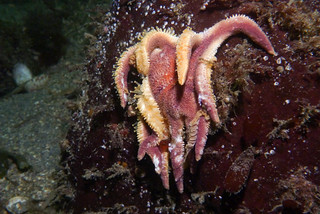



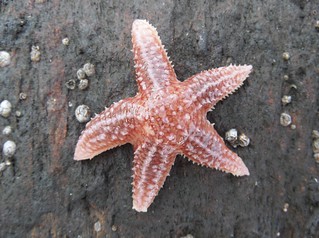
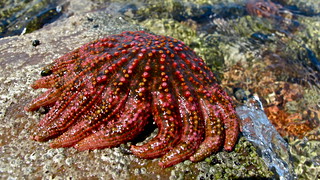
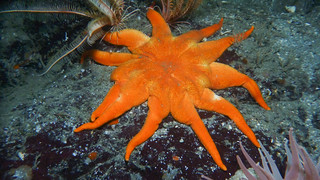
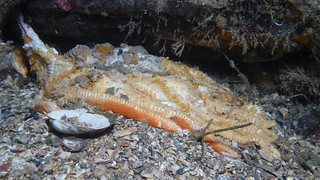

36 comments:
There is no massive die off of starfish in BC. Just a localized problem around Vancouver. I live and run a dive charter on Vancouver Island and checked with a lot of colleges who have NOT seen this. Here in barkley Sound the starfish are doing fine. BC coastal waters run from Washington state all the way up to Alaska. Maybe Cary Arnold fron Nat Geo should take some “Geographic” remediation classes
In the last 2 weeks, divers have been reporting this same phenomenon all around Monterey Bay in California.
See http://groups.yahoo.com/neo/groups/ba_diving/conversations/topics
It's either an astonishing coincidence, or a very real problem affecting much of the west coast of North America.
Hmm.. that's not good...I'll spread it around..
I went out on Friday to take pictures in Monterey. I found distressed starfish immediately. (I also photographed some that were not distressed, in case that helps)
You can browse them online at http://www.flickr.com/photos/rwolf01/sets/72157636492918173/ or just download the whole dataset, with temperature & depth profiles & dive site locations from https://www.dropbox.com/s/803aj3k38u8u2t0/Smaller.zip
Oops, that 'unknown' comment was me.
thanks Ralph, were they largely free of the white lesions? Just for the sake of consistency what was your criterion for "distressed" starfish pictures?
I see some of the animals show damage. I'll pass your images onto the network...
Here are some links to the monitoring sites that have been set up by UC Santa Cruz http://www.eeb.ucsc.edu/pacificrockyintertidal/data-products/sea-star-wasting/index.html
http://data.piscoweb.org/marine1/seastardisease.html
I'd already seen examples from your & Dr Gong's blogs and from a dive a week earlier, so I set out to only shoot sea stars and was expecting to find trouble.
Once I was diving, I cast a wide net to minimize sampling bias, including examples of healthy looking stars.
Basically, I swam slow and shot fast, only skipping stars when I'd already photographed it's twin, or if it was too deep in a crack or overhang to be shot with a wide-angle lens.
That said, I over weighted the unusual ones: dismembered stars or ones with limbs coiled or twisted up definitely got photographed.
I also shot a few bat stars that just looked funny... discolored spots, on atypical substrate, curling up at the edges, etc.
There was a giant spined star that was hanging by 2 legs, with the other 3 limp and waving in the surge. That was unique, so I shot it.
It's pretty severe. A large fraction of the sea stars I saw were obviously not well.
My data is very localized. Both sites were close together on the north side of the Monterey peninsula. Carmel Bay & Big Sur might be totally fine, or it could be bad along the entire coast.
I'll ask around...
Marty Overson, a regular & respected contributor to BA_diving dove at South Monastery Beach, CA yesterday.
This site is about 8 miles south of where my pictures were taken (see google earth) but he reports "I looked hard for
the deteriorating Star Fishes and to my relief, I didn't see anything out of the normal. There were a few re-growing limbs but I figure, that was what I usually see, noting like the pictures Ralph posted."
That lends credibility to Peter's post above (though I still don't care for his tone :)
These two sites are separated by the Monterey Peninsula. If the disease is concentrated near local water sources, such as rivers or municipal waste water, that might be an important clue to the cause.
Charlie Schaffer: I saw disintegrating spiny or knobby sea stars. I started seeing them about two weeks ago off Pescadero Point in Carmel Bay (at the mouth of Stillwater Cove so maybe warmer on average..) (picture of arm in a sea anemone here: https://plus.google.com/photos/110159573286645489662/albums/5937685206246954433?authkey=CMyMhNa09eGT8wE )and on Chase Reef between Lover's Point and Point Pinos is Monterey Bay. I saw one disintegrating knobby sea star on the Pinnacles in Carmel Bay this week.
Question - are there other known or recognized sea star diseases that present differently than wasting disease?
There aren't really other starfish diseases known..
November 8, 2013. I saw 4 ochre stars with wasting disease at Long Point, Palos Verdes, in Los Angeles county. 45fsw contour line, 61F water temp. Giant spined stars looked healthy. Thousands of bat stars also appeared unaffected.
Claudette, thank you! that's new for Southern California. Do you have pictures?
4I've been following your blog on the starfish wasting and thought I should get in contact with you. I run a company out in Oregon called Coldwater Marine Aquatics and we collect and retail temperate water specimens from the Oregon coast. Right now in our holding tanks I think we have at least 7 starfish species from the Oregon coast.
We collect for sale and also personally keep in our own home aquariums several of the affected species. Some of which I've observed the wasting personally in our holding tanks as well as in the wild. We regularly collect specimens from several locations along our coast line and we track when and where they are collected to report on our permits.
If you or anyone you know is doing research on any of these species and is interested we'd love to help out and provide specimens for research.
Also, if you are on facebook, there is a discussion group that's setup for keepers of temperate and cool water home aquariums, and almost all of them keep at least one of the affected species in their home aquariums. Perhaps more first hand accounts or opportunities for crowd sourced research? www.facebook.com/groups/ColdwaterOwners
Cheers!
Stu Wobbe
Coldwater Marine Aquatics
Just went out to the intertidal zone at Abalone Cove, Palos Verdes, California and only found one ochre sea star when there are normally hundreds in this location during such an extreme low tide. This ochre sea star had lesions. We also found a small bat star that appeared dead. It didn't appear to have the disease but was off color and bedraggled looking. Images available at http://www.flickr.com/photos/ronkacmarcik/11200932533/ and http://www.flickr.com/photos/ronkacmarcik/11200810994/
Kazmaniac. Sometimes it is difficult to tell from photos whether something is sick. The pics you've linked to look relatively healthy.. no necrosis or white lesions. But again, difficult to say from pictures alone.
The UCSC site has some great pics showing symptoms http://www.eeb.ucsc.edu/pacificrockyintertidal/data-products/sea-star-wasting/index.html
thanks for your interest and input!
ChrisM: I sent the photos to UC Santa Cruz and they confirmed that the Ochre Sea Star did have lesions and the Bat Star did not have them. If you zoom in on the Ochre Sea Star you can see a couple of small lesions starting on the center disk and a more substantial lesion on the lower right arm. I didn't notice them when I first took the picture but since it was the only sea star in the area I took a closer look when I got home. Definitely not as noticeable as most of the example photos on the UCSC website. I hear that it spreads quickly but the tides aren't low enough to enable me to follow up anytime soon.
Here in Woods Hole, Massachusetts, where we run a specimen collating department for the Marine Biological Laboratory, we have been watching this impacting Asterias forbesi. We've seen it intermittently for some time. It strikes very quickly. For example, late spring and summer of 2013 we were seeing a recovery from the previous year and saw our first large specimens. We have several hundred in our facility and just two weeks ago started finding the tell-tale signs of disease in separated limbs. It affected all tanks at once, all of which are on ambient water from the harbor. I wish I had one of the tanks on a re-use loop.
I can also verify that this problem has been noted up and down the east coast. As a supplier of Asterias, I was fielding requests in 2012-13 from Maine through South Carolina. People just were not finding them.
David, THANK YOU! Great to have some info from the East coast!
Here is a link to images taken Dec. 3rd on a low tide beach walk on Vashon Island, Washington. Clearly showing SWS in most of the sea stars observed.
https://plus.google.com/photos/116927831359749283306/albums/5953732639225930145?authkey=CM_pvrDZ-qySuAE
Wow Isle Flag! thank you! the pictures are interesting.
ok my mom and i are all into natural cures so we were thinking that if u
you sprinkle some bentonite clay and/or diatomaceous earth in the water which is known to absorb toxins could it help heal the sea stars? i realize that the water need to be circulated but is there byway this experiment could be tried? even just to rule it out as a possible cure? pls respond if u try it or if you have other ideas about this. my email is paris555larohe@hotmail.com
Diatomaceous earth is sediment composed of small marine algae called diatoms. These are ALREADY naturally occurring in the ocean. Drying them out and putting them back in the ocean does nothing. Bentonite is clay, which would be inert in the ocean.
Neither of these substances are bioactive.
Just found this post. It's now in olympia, washington as well. Started with coastal waters and is now moving to bays and inlet areas.
I live in Maine and conducting some personal research on Sea Star wasting (SSW). I have recently been involved in researching Lobster shell disease and investigating viruses that infect bacteria associated with the lesions on the lobster shell.We've been finding some very interesting interactions within the bacterial community in regards to when viruses appear and it makes me wonder about SSW. Some observations I've noted are first, I find it interesting that Lobster Shell Disease and Sea Star Wasting were first, originally reported on the east coast from within the same area (Rhode Island). Second, I found David Remsen's comment about about it coming on quickly in tanks that pump in harbor water . ... . I'm having trouble finding publications on the east coast aspect, anyone have some leads for me? Thank you!
Sadly, there are not yet any published scientific accounts of east coast Asterias die offs. There are a lot of public accounts (google Asterias or east coast starfish die off) but none that document the more specific aspects.
I just finished reading the May 2, 2014 Science Magazine about the Wasting Disease. It was the first mention I had seen that the disease was being found in a number of Echinoderm species besides Sea Stars. I had wondered if that was so a few weeks ago when I began to encounter fair numbers of Sand Dollars at a remote beach where I had never encountered them before. Besides still being purple, an indication of recent death, and a rarity in itself when I find them, 90% had been recruited by barnacles. Researching that online I read that a few years ago this increased recruitment had been noticed in the Pismo Beach area. I had wondered if the barnacle was interfering in the Sand Dollar burying itself, thereby making it more vulnerable to beaching. Now I'm wondering if a disease is the root cause. Any thoughts or sites this info should be reported to would be appreciated. Thanks for your time. John Vonderlin
John,
so just that we are clear.. the sand dollar species is Dendraster excentricus and it has a large "acorn barnacle" on the test called Paraconcavus pacificus (formerly called Balanus pacificus).
There are papers which have observed this association which extend back over 40 years (I found one from 1970) and have speculated on the same thing that you have, namely does the barnacle contribute to higher mortality? But living sand dollars with living barnacles have been observed. They likely exploit the same optimal current flow for feeding.
I've not tracked down every paper but offhand I would think that populations occurrence of this phenomena are not very well documented. Any recent studies of the association are likely to result in better and thus, "higher" recorded incidence from various localities.
There are no records or any data of sand dollars being affected by wasting syndrome along the California coast that I am aware of.
I am unaware of any data which links these phenomena. Lots of reasons might explain what might be perceived as higher incidence. Including as above, better data but also, simply good water flow or ideal conditions (nutrients, environment, etc.).
Hope that helps with your question. thanks for your interest!
Chris
John,
I would add that you are always welcome to simply make observations of the barnacles on Dendraster on iNaturalist http://www.inaturalist.org/
which would contribute towards our understanding of their natural occurrence.
thanks.
I found two Pisaster this morning in Edmonds beach with clear signs of starfish wasting disease, one only had three legs, both with clear lesions and loss of hydrostatic pressure. Quite a few others seemed unaffected so perhaps it has just hit.
Also no Pycnogonus (sunflower seastars) where they usually are at low tide, perhaps they have already been affected.
Could fish farming and its dreaded consequence sea lice have a role in this disaster.
Is there a published reference for the appearance of wasting disease in Asterias rubens in 1972? i.e., "The symptoms of the disease have been observed as early as 1972 from the east coast of North America in the "common" starfish Asterias vulgaris (now called Asterias rubens, pic on the left"
see the ref on Asterias mentioned in my post:
http://www.mednscience.org/sites/default/files/products/Eckert_Sea_Star_Disease_Population_Decline.pdf
Thank you, Chris. I found Menge 1979.
Post a Comment